Trail cameras on the Platte River catches sandhill cranes on their bellies.
Enlarge

Photo by Eric Fowler, Nebraskaland Magazine
Story and photos by Eric Fowler
Do sandhill cranes sleep? On their bellies? In a wooded creekbottom?
From what we know about the cranes that stop in the Platte River Valley in Nebraska each spring, none of those ideas seem to make sense. It certainly didn’t to Chris Helzer of the Nature Conservancy, whose tip on this seemingly odd behavior spurred me to spend two days in a photo blind last spring and find out that some cranes do, indeed, sleep in the woods. Well, at least sort of.
Several years ago, Helzer had noticed sandhill cranes were spending time in the woodlands on their property along a stream that was once the south channel of the Platte River south of Wood River. Curious, he had Karen Hemberger, a long-time volunteer from Hastings, set up trail cameras to see what they were doing. After those cameras captured video of the birds on their bellies, Helzer thought: “That seems weird, but really cool.
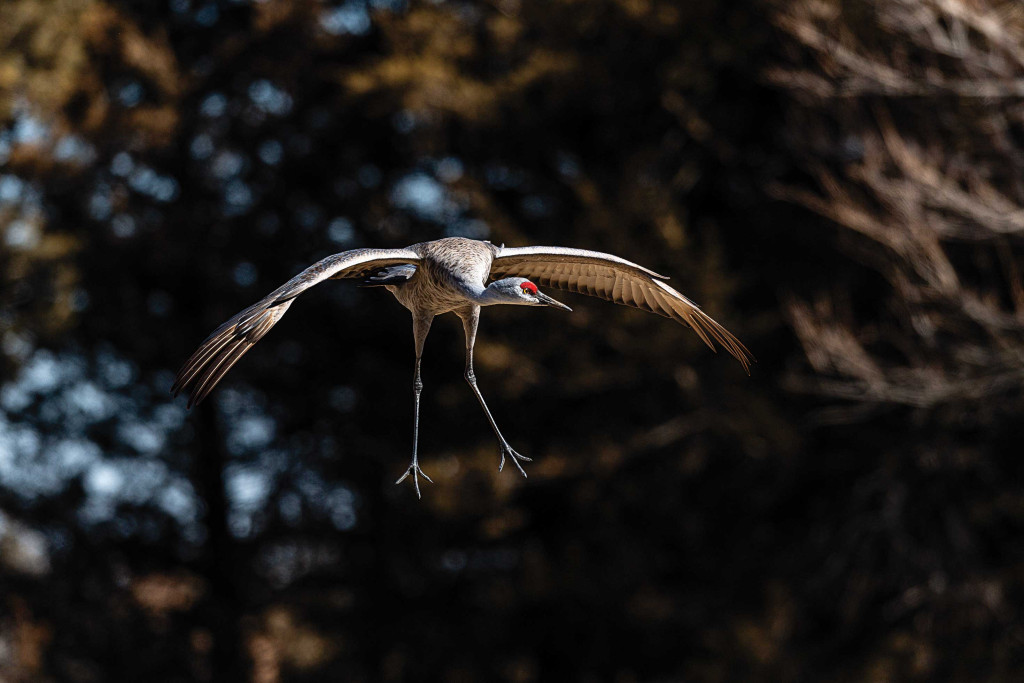
“Everything I’ve heard about cranes was that they spent most of their time in the open so they could see predators coming. So, I was surprised, in the first place, that they were in the trees. And then when I saw them lying on the ground and how hard it was for them to get up, then I was really surprised. It seemed like they were making themselves really vulnerable to potential predation.”
With tips from TNC staff and some scouting, I found a spot the cranes were using along the stream, which you could also call a slough. Disconnected from the river at the upper end long ago, it is fed entirely by groundwater and flows intermittently depending on the season and the year. Last spring, it was not flowing, only holding water in low spots. To the north is a privately owned pasture. To the south is a native lowland tallgrass prairie laced with wet meadow swales the Nature Conservancy acquired in 2007. A decade ago, they cleared brush and smaller trees from the creekbottom, leaving cottonwoods and other larger trees, to create a savanna-type habitat. The stream bed sits about 8 feet below those grasslands, and 3 feet below the bottomland prairie and forest it winds through. The muddy banks of the stream in the spot I chose were littered with crane tracks, and the grass with feathers and down.
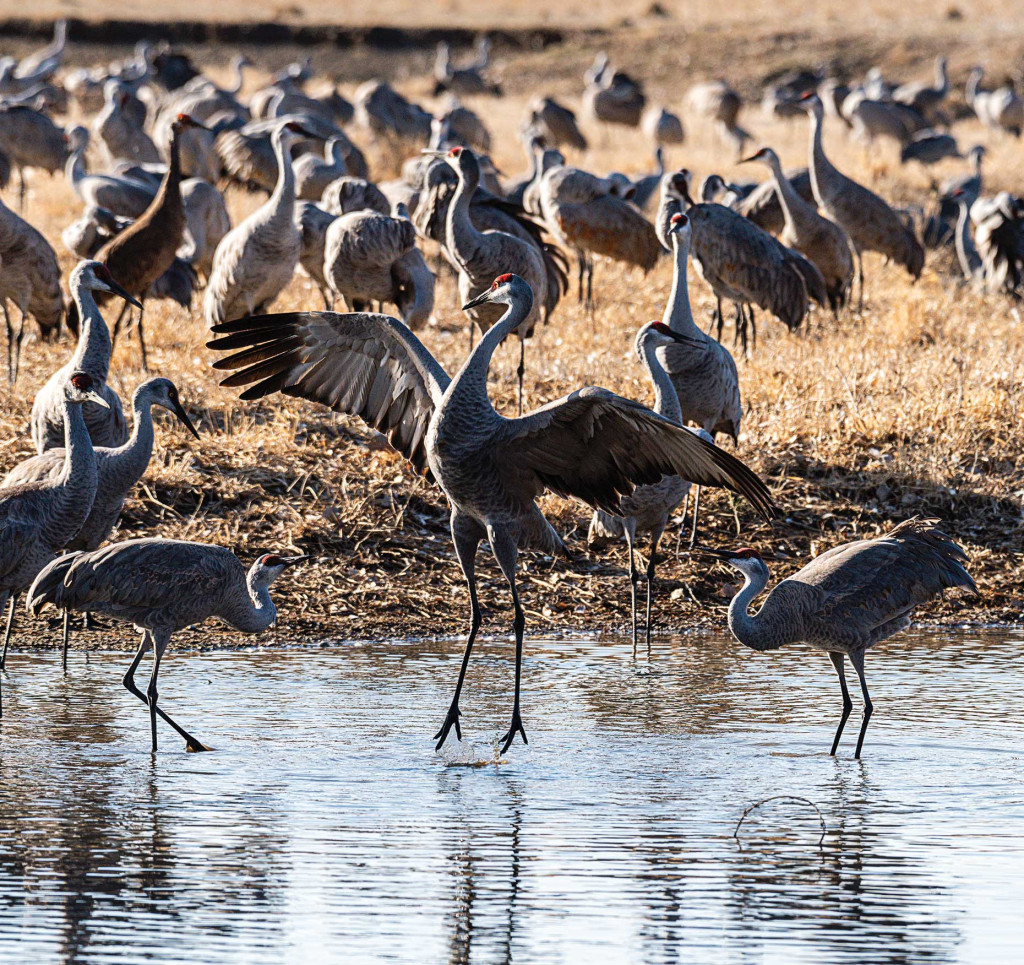
On both of my visits in mid- to late March, many cranes had already left their roost on the Platte a half mile north of me and were feeding in crop fields and wet meadows on both sides of the stream when I arrived at sunrise. They continued to leave the river in waves as I set up my blind on the south bank of the creek and settled in for the day.
Cranes started arriving late in the morning on my first visit and early in the afternoon on the second, dropping in a few at a time at first and then in bunches. I watched as they loafed in the grass and preened their feathers. A few at a time, they walked down to the stream to drink or probe the mud with their long beaks for invertebrates and plants. One sat down in the water and took a bath. The birds seemed to wander back and forth across the bottom, individually or in family groups. Temperatures were in the 50s both days with nary a cloud in the sky. On the first day, when south winds gusted to nearly 40 mph, some birds took cover next to willow thickets growing on the south edge of the bottom.
On both days, birds were resting, including on their bellies, soon after arriving. The birds appeared to be much more at ease on my second visit, however, when winds were much calmer. Some pecked at the grass, which by now had been beat down by their presence during the previous few weeks, possibly eating insects. A few danced, something I’d seen little of a week earlier. An hour or so after the birds arrived, most were resting, some on their bellies, some standing on one leg, the other tucked up in their belly, and others on two legs. Whether they were upright or lying down, some cranes had their heads turned and tucked beneath a wing, some had their bill pointed down, resting on their upright neck, and others simply rested with their head up and eyes closed, revealing the tiny white feathers on their eyelids. Some stood in the creek as they slept.
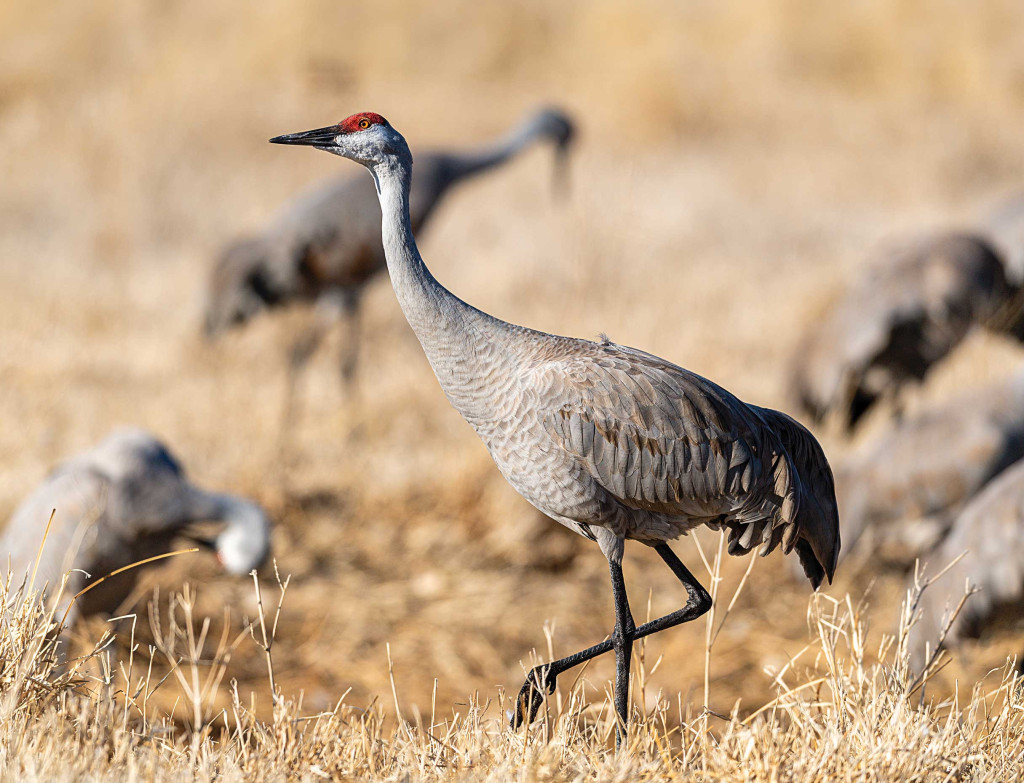
The cranes that were lying down got there slowly and awkwardly. The proportions of a bird’s leg and foot bones differ greatly from ours. The thigh and knee of cranes and other birds are hidden by the feathers on their bellies. The joint we see between their two longest and most visible bones is actually what would be our ankle, known as the hawk joint. The lower of those two bones is comparable to the long bones in our feet, between our ankle and toes. To sit, the cranes dropped backward on that hawk joint, and then settled their bodies forward onto the ground. I watched some birds wander for a bit, examining the ground here and there before picking a spot to lie down. One bird, upon finding that spot, turned in a circle like a dog might before settling down.
There were always some cranes on alert, and the heads of those resting snapped to attention when a strange sound or the call of alert birds gave warning. Birds on their bellies sometimes simply lifted their heads when alerted. Other times, they were on their feet in a split second in an effortless motion, unlike their lumbering efforts to lie down, and much quicker than what Helzer had seen in their videos.
“That was like watching some kind of robot that hasn’t been perfected yet,” he said.
The birds left en masse late in the afternoon on my first visit, presumably startled by something. They stayed into the evening on the second, leaving in bunches until the last of them departed an hour before sunset, heading to the fields and meadows one last time before returning to their river roost.

In the Woods
More than 1 million sandhill cranes stop along central Platte River each spring. They are most often seen roosting on the widest, most open, segments of the river at night, and feeding and loafing in wide-open crop fields and wet meadows during the day.
There are five subspecies of sandhill cranes in North America. Two, the lesser and greater, are migratory. These are the birds we see in Nebraska, all heading from their wintering grounds in the southern United States and Mexico to their breeding grounds scattered across the northern U.S., Canada, Alaska and into Siberia. Among the two migratory subspecies are four breeding populations, each with their own habitat preferences. The common view that cranes only use open spaces was adopted because many of the birds that stop here do. But that is not the case.
“Sometimes when you see weird stuff like that, it’s actually because we’ve made generalities to the mid-continent population as a whole,” said Andy Caven, the Vice President of North America Programs with the Crane Foundation who spent nine years working on the Platte with the Crane Trust. “Some of those way western birds, the lessers, will deal with willow thickets and stuff like that a little bit differently because the only place where there’s water in the landscape is shrubby stuff.”
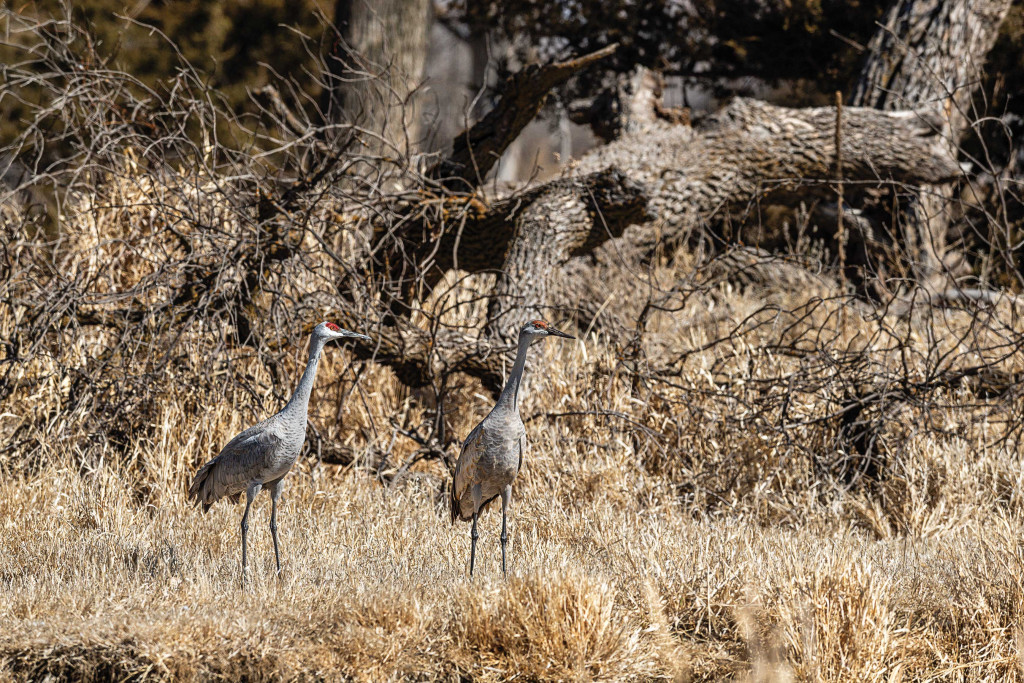
Conservation photographer Michael Forsberg began his career with Nebraskaland Magazine and has photographed the birds across North America. Some of the greater sandhill cranes, he said, especially those of southern Canada and western Minnesota, nest in deep wetlands with more cover than birds nesting on the Arctic tundra. “They’re taller birds that are maybe more comfortable in situations that have more woodlands,” Forsberg said.
“Sandhill cranes, besides just being really resilient, I think they use a lot more different types of habitats than people give credit for. They definitely have their preferences, but they will make whatever works work. They need grasslands and wetlands, but I’m not sure they’re as picky as people think.”
Forsberg captured the photos for his first article on cranes that appeared in this magazine in 1996 along the same stream a mile to the east. The birds I watched filled a 60-yard-wide gap between larger trees and had a clear flight path in and out from both the north and the south, a site similar to the one Forsberg chose.
From my blind, I had a narrow field of view of a short stretch of the stream, and none of the birds I saw were actually “in” the woods as much as next to them, walking within a few yards of thickets and grass-choked deadfall. I had, however, seen signs of cranes using areas with more cover. Forsberg had a different view and watched birds, after they dropped into the opening, walk up and down the stream, even through wooded sections. He also saw them wander to and from the adjacent prairie. I didn’t see that movement from my blind, but it could have been happening, as there were birds in the prairie to the south and the pasture to the north each time I visited.
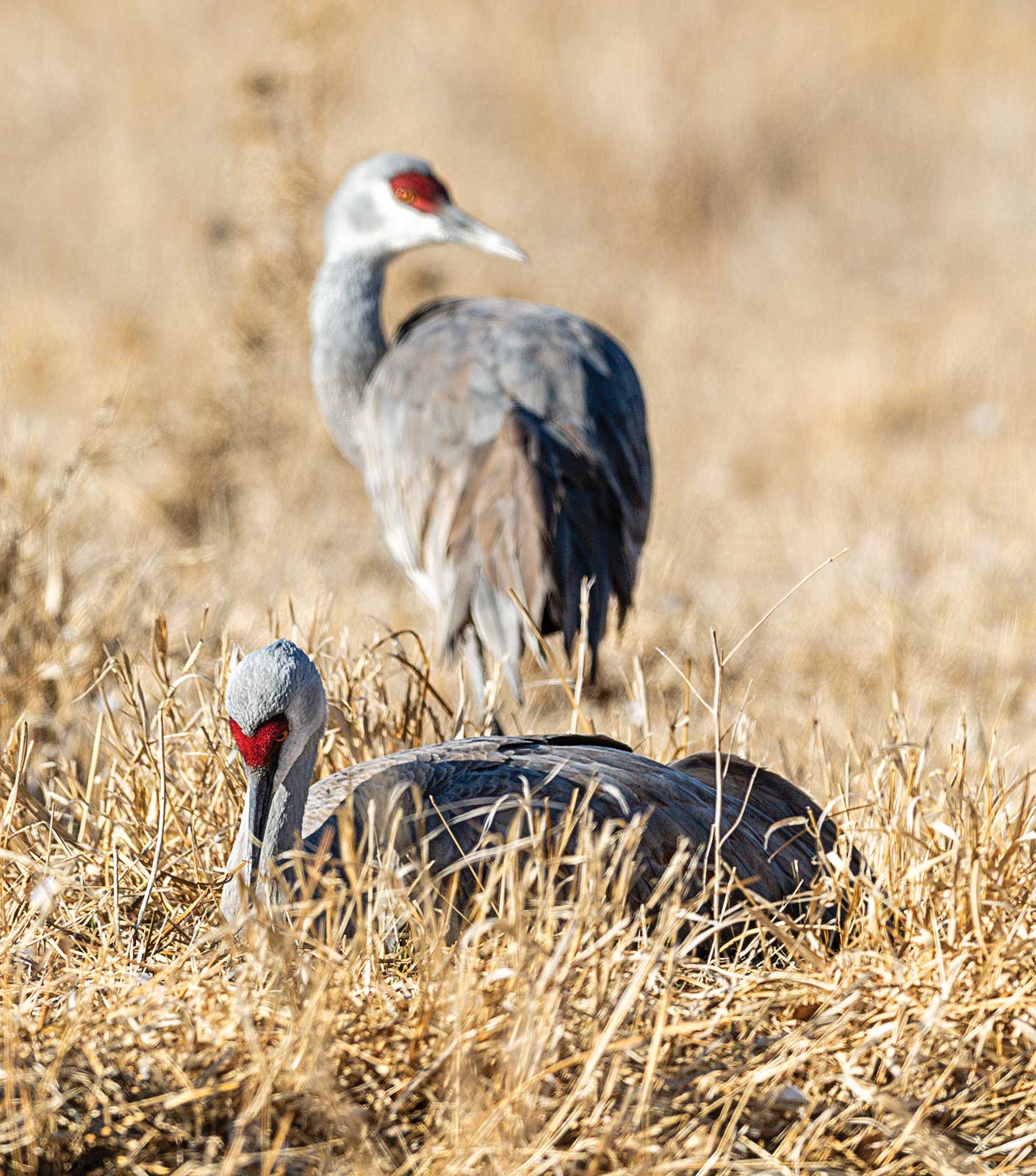
Cranes that spend the day in fields and meadows along the Platte might land close to a road, but they don’t typically stay there when a car passes. The closest road to the section of stream where I spent my time is 200 yards to the north, and it is traveled by far fewer crane watchers than others in the region during March. That alone could explain why these birds like the spot. While working on his book, Great Plains: America’s Lingering Wild, Forsberg said the places he saw the most wildlife weren’t always the best habitat. “You know where they were? They were in the places that were the most quiet and had the least amount of us,” he said.
Sleeping
So were the cranes I watched sleeping? Anne Lacy, Director of Eastern Flyway Programs with the International Crane Foundation in Baraboo, Wisconsin, has been studying cranes since 2000 and uses that term loosely. “I want to be careful about the word sleep, because when I think of the human form of sleep, where we are literally zonked out and dreaming, I don’t know if cranes do that,” Lacy said, noting she prefers to use words like resting and loafing to describe the behavior. “They might rest, but I think it’s more of shutting down half of their brain because the littlest noise and, ‘Boom!’ they’re awake and aware.”
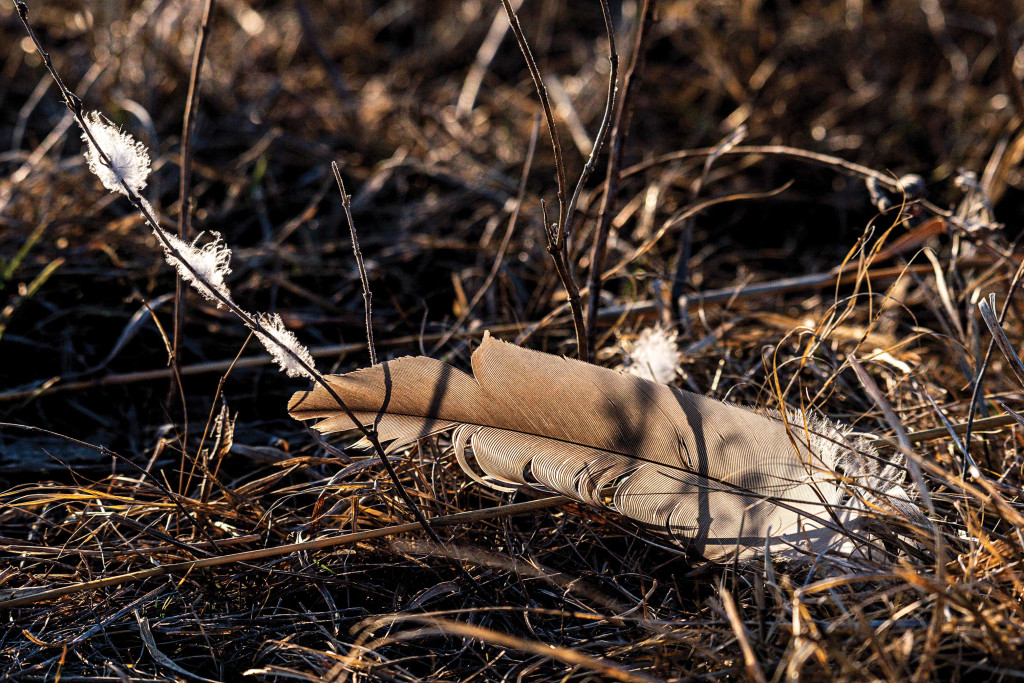
Lacy visits the Platte each spring and has watched from bank blinds in the evening and early morning hours as birds roost in the river. In the dark, she said, those birds are always on alert, and she wonders if those with their heads tucked under their wings might be doing so more to conserve body heat than rest. “But when they go out in the morning and find their foraging fields, they’ll get a bite to eat, and then they will find a place to loaf and/or ‘sleep’,” Lacy said. “The predators that try to make snacks out of a crane are more active at night than during the day, so they can afford to shut down a little bit more during the day. And they’re usually in a crowd of their compatriots, and if somebody twitches, by god, nobody is looking around saying, ‘Hey, what’s going on?’ They’re all up in the air, and they’re gone. There’s always that situational awareness, even though their head is tucked and they’re on the ground and their eyes might even be closed.”
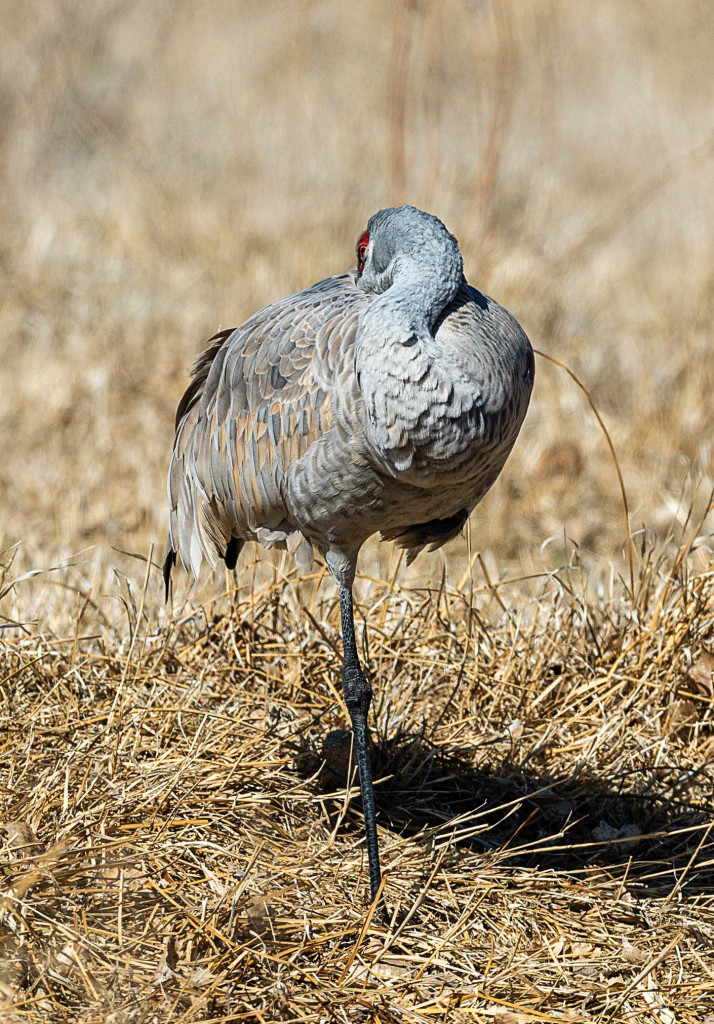
All is Well
Cranes were likely using this stretch of the stream creek long before Forsberg photographed them there. Helzer can’t say for sure if they are using it more since the habitat was improved, but he would like to think so. He sees birds in other places he was told he wouldn’t when he started working in the valley 30 years ago, including prairies where their heads barely rise above the tall grass. He was happy to learn cranes using this woodland stream wasn’t as odd as he initially thought, and that they could stand up much quicker than what he had seen were a bobcat or coyote to jump into the fray. “That makes me feel better,” he said.
The post Do Cranes Sleep? appeared first on Nebraskaland Magazine.
















